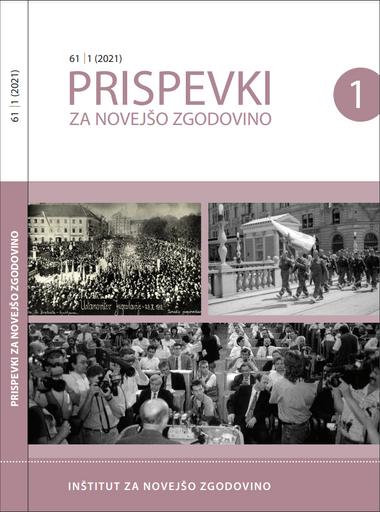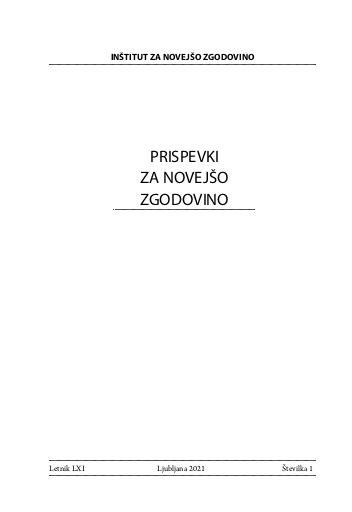/
Serijske publikacije
/
Prispevki za novejšo zgodovino
Trikrat
Sosledje v zgodovinskem dogajanju na poti do slovenske državnosti v 20. stoletju


To delo avtorja Zdenko Čepič je ponujeno pod Creative Commons Priznanje avtorstva-Brez predelav 4.0 Mednarodna
Datoteke (2)

Opis
The Slovenian state was formed in the “short” 20th century". Slovenians have attained the state that they now live in gradually, in three steps (in 1918, 1941–45, and 1990–91). The formation of the Slovenian statehood involved cohesion, a sequence of events. Without the attainment of the initial Slovenian statehood, the second step would not have taken place, while the third stage would have been particularly impossible without the second one. Each of the steps towards the establishment of the Slovenian statehood occurred in its own period, subject to various conditions that influenced the process of the creation of the Slovenian state and the degree of its independence. The first step was taken at the end of World War I, after the state-legal ties with the Austro-Hungarian state had been severed due to the international political circumstances and Slovenians joined the State of Slovenes, Croats, and Serbs. This state then “merged” with the Kingdom of Serbia to form the Kingdom of Serbs, Croats, and Slovenes (as of 1929, the Kingdom of Yugoslavia). The second step took place during World War II, after the former Yugoslav state had collapsed and needed to be restored in new circumstances and with a different organisation – which was, during the war, the goal of the so-called bourgeois political camp, the traditional Slovenian political parties, as well as the so-called revolutionary camp or the liberation movement. The third step, however, occurred when the Yugoslav state, organised in accordance with the criteria of the liberation movement that had prevailed during the war, outlived its purpose. All three steps shared the same goal, while the manners of attaining statehood and the attitude towards it varied, depending on the situation and relations between the factors or proponents of statehood as well as on its political or social agents. The formation of the Slovenian statehood in the “short 20th" century” was related to the right to self-determination. This right represented the means or the foundation for the construction of statehood during each phase and was understood somewhat differently during each of the stages of the Slovenian statehood’s formation. Self-determination was an essential condition that made it possible for Slovenians to attain their own state at all –during all three stages of its creation.
Metapodatki (13)
- identifikatorhttps://hdl.handle.net/11686/45335
- naslov
- Trikrat
- Sosledje v zgodovinskem dogajanju na poti do slovenske državnosti v 20. stoletju
- Three Times: The Sequence of Historical Events Leading to the Slovenian Statehood in the 20th Century
- avtor
- Zdenko Čepič
- soavtor
- Jure Gašparič (gl. ur.)
- Andreja Jezernik (lekt.)
- predmet
- Slovenija
- država
- politika
- samoodločba
- jugoslovanstvo
- slovenstvo
- Slovenia
- state
- politics
- self-determination
- Yugoslavism
- Slovenism
- opis
- Slovenska država je nastala v »kratkem 20. stoletju«. Slovenci smo do države, ki jo imamo sedaj, prišli postopoma. V treh korakih: 1918, 1941–45, 1990–91. Pri tem je šlo pri nastajanju slovenske državnosti za povezanost, za sosledje. Brez dosežene prve slovenske državnosti ne bi bilo druge, zlasti pa brez druge ne bi bilo tretje. Vsak korak oblikovanja državnosti se je zgodil v svojem obdobju, v različnih pogojih, ki so vplivali na potek nastajanja države in stopnjo njene samostojnosti. Do prvega je prišlo ob koncu prve svetovne vojne, ko so bile zaradi mednarodnih političnih pogojev pretrgane državnopravne vezi z avstro-ogrsko državo in smo Slovenci vstopili v Državo Slovencev, Hrvatov in Srbov, ta pa se je nato s Kraljevino Srbijo »zedinila« v Kraljevino Srbov, Hrvatov in Slovencev (od leta 1929 Kraljevino Jugoslavijo), drugi se je zgodil v času druge svetovne vojne, ko je jugoslovanska država doživela kolaps in jo je bilo treba obnoviti, in to v novih pogojih, z novo organizacijo, za kar so se v vojnem obdobju zavzemali v t. i. meščanskem političnem taboru, v tradicionalnih slovenskih političnih strankah in tudi v t. i. revolucionarnem taboru oziroma v osvobodilnem gibanju, tretji pa takrat, ko se je jugoslovanska država, ki je bila organizirana po merilih v vojni zmagovitega osvobodilnega gibanja, izpela. Vsem trem korakom je bil skupen namen, medtem ko sta bila način do državnosti in odnos do nje različna. Način državnosti in odnos do nje sta bila odvisna od razmer pa tudi razmerij med dejavniki oziroma ustvarjalci državnosti in od političnih ali družbenih nosilcev. Oblikovanje slovenske državnosti v »kratkem 20. stoletju« je povezano s samoodločbo. Bila je sredstvo ali osnova, na kateri je bila državnost na vsaki posamezni stopnji zgrajena. V vsakem od korakov oblikovanja državnosti je bila nekoliko drugače razumljena. Samoodločba je bila bistven pogoj in sredstvo, da smo Slovenci do države sploh prišli. V vseh treh korakih njenega ustvarjanja.
- The Slovenian state was formed in the “short” 20th century". Slovenians have attained the state that they now live in gradually, in three steps (in 1918, 1941–45, and 1990–91). The formation of the Slovenian statehood involved cohesion, a sequence of events. Without the attainment of the initial Slovenian statehood, the second step would not have taken place, while the third stage would have been particularly impossible without the second one. Each of the steps towards the establishment of the Slovenian statehood occurred in its own period, subject to various conditions that influenced the process of the creation of the Slovenian state and the degree of its independence. The first step was taken at the end of World War I, after the state-legal ties with the Austro-Hungarian state had been severed due to the international political circumstances and Slovenians joined the State of Slovenes, Croats, and Serbs. This state then “merged” with the Kingdom of Serbia to form the Kingdom of Serbs, Croats, and Slovenes (as of 1929, the Kingdom of Yugoslavia). The second step took place during World War II, after the former Yugoslav state had collapsed and needed to be restored in new circumstances and with a different organisation – which was, during the war, the goal of the so-called bourgeois political camp, the traditional Slovenian political parties, as well as the so-called revolutionary camp or the liberation movement. The third step, however, occurred when the Yugoslav state, organised in accordance with the criteria of the liberation movement that had prevailed during the war, outlived its purpose. All three steps shared the same goal, while the manners of attaining statehood and the attitude towards it varied, depending on the situation and relations between the factors or proponents of statehood as well as on its political or social agents. The formation of the Slovenian statehood in the “short 20th" century” was related to the right to self-determination. This right represented the means or the foundation for the construction of statehood during each phase and was understood somewhat differently during each of the stages of the Slovenian statehood’s formation. Self-determination was an essential condition that made it possible for Slovenians to attain their own state at all –during all three stages of its creation.
- založnik
- Inštitut za novejšo zgodovino
- datum
- 01. 01. 2021
- tip
- besedilo
- identifikator
- COBISS.SI-ID 68208899
- jezik
- Slovenščina
- jeDelOd
- pravice
- licenca: ccByNd
